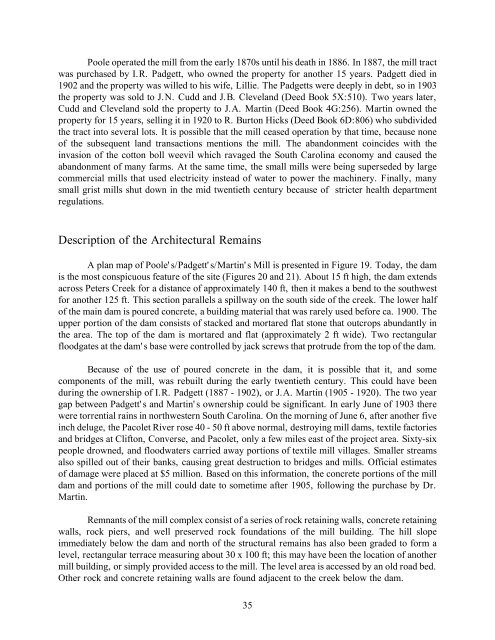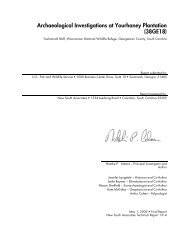Mills in the Upcountry: a Historic Context, and a Summary of a Mill ...
Mills in the Upcountry: a Historic Context, and a Summary of a Mill ...
Mills in the Upcountry: a Historic Context, and a Summary of a Mill ...
Create successful ePaper yourself
Turn your PDF publications into a flip-book with our unique Google optimized e-Paper software.
Poole operated <strong>the</strong> mill from <strong>the</strong> early 1870s until his death <strong>in</strong> 1886. In 1887, <strong>the</strong> mill tract<br />
was purchased by I.R. Padgett, who owned <strong>the</strong> property for ano<strong>the</strong>r 15 years. Padgett died <strong>in</strong><br />
1902 <strong>and</strong> <strong>the</strong> property was willed to his wife, Lillie. The Padgetts were deeply <strong>in</strong> debt, so <strong>in</strong> 1903<br />
<strong>the</strong> property was sold to J.N. Cudd <strong>and</strong> J.B. Clevel<strong>and</strong> (Deed Book 5X:510). Two years later,<br />
Cudd <strong>and</strong> Clevel<strong>and</strong> sold <strong>the</strong> property to J.A. Mart<strong>in</strong> (Deed Book 4G:256). Mart<strong>in</strong> owned <strong>the</strong><br />
property for 15 years, sell<strong>in</strong>g it <strong>in</strong> 1920 to R. Burton Hicks (Deed Book 6D:806) who subdivided<br />
<strong>the</strong> tract <strong>in</strong>to several lots. It is possible that <strong>the</strong> mill ceased operation by that time, because none<br />
<strong>of</strong> <strong>the</strong> subsequent l<strong>and</strong> transactions mentions <strong>the</strong> mill. The ab<strong>and</strong>onment co<strong>in</strong>cides with <strong>the</strong><br />
<strong>in</strong>vasion <strong>of</strong> <strong>the</strong> cotton boll weevil which ravaged <strong>the</strong> South Carol<strong>in</strong>a economy <strong>and</strong> caused <strong>the</strong><br />
ab<strong>and</strong>onment <strong>of</strong> many farms. At <strong>the</strong> same time, <strong>the</strong> small mills were be<strong>in</strong>g superseded by large<br />
commercial mills that used electricity <strong>in</strong>stead <strong>of</strong> water to power <strong>the</strong> mach<strong>in</strong>ery. F<strong>in</strong>ally, many<br />
small grist mills shut down <strong>in</strong> <strong>the</strong> mid twentieth century because <strong>of</strong> stricter health department<br />
regulations.<br />
Description <strong>of</strong> <strong>the</strong> Architectural Rema<strong>in</strong>s<br />
A plan map <strong>of</strong> Poole' s/Padgett' s/Mart<strong>in</strong>' s <strong>Mill</strong> is presented <strong>in</strong> Figure 19. Today, <strong>the</strong> dam<br />
is <strong>the</strong> most conspicuous feature <strong>of</strong> <strong>the</strong> site (Figures 20 <strong>and</strong> 21). About 15 ft high, <strong>the</strong> dam extends<br />
across Peters Creek for a distance <strong>of</strong> approximately 140 ft, <strong>the</strong>n it makes a bend to <strong>the</strong> southwest<br />
for ano<strong>the</strong>r 125 ft. This section parallels a spillway on <strong>the</strong> south side <strong>of</strong> <strong>the</strong> creek. The lower half<br />
<strong>of</strong> <strong>the</strong> ma<strong>in</strong> dam is poured concrete, a build<strong>in</strong>g material that was rarely used before ca. 1900. The<br />
upper portion <strong>of</strong> <strong>the</strong> dam consists <strong>of</strong> stacked <strong>and</strong> mortared flat stone that outcrops abundantly <strong>in</strong><br />
<strong>the</strong> area. The top <strong>of</strong> <strong>the</strong> dam is mortared <strong>and</strong> flat (approximately 2 ft wide). Two rectangular<br />
floodgates at <strong>the</strong> dam' s base were controlled by jack screws that protrude from <strong>the</strong> top <strong>of</strong> <strong>the</strong> dam.<br />
Because <strong>of</strong> <strong>the</strong> use <strong>of</strong> poured concrete <strong>in</strong> <strong>the</strong> dam, it is possible that it, <strong>and</strong> some<br />
components <strong>of</strong> <strong>the</strong> mill, was rebuilt dur<strong>in</strong>g <strong>the</strong> early twentieth century. This could have been<br />
dur<strong>in</strong>g <strong>the</strong> ownership <strong>of</strong> I.R. Padgett (1887 - 1902), or J.A. Mart<strong>in</strong> (1905 - 1920). The two year<br />
gap between Padgett's <strong>and</strong> Mart<strong>in</strong>'s ownership could be significant. In early June <strong>of</strong> 1903 <strong>the</strong>re<br />
were torrential ra<strong>in</strong>s <strong>in</strong> northwestern South Carol<strong>in</strong>a. On <strong>the</strong> morn<strong>in</strong>g <strong>of</strong> June 6, after ano<strong>the</strong>r five<br />
<strong>in</strong>ch deluge, <strong>the</strong> Pacolet River rose 40 - 50 ft above normal, destroy<strong>in</strong>g mill dams, textile factories<br />
<strong>and</strong> bridges at Clifton, Converse, <strong>and</strong> Pacolet, only a few miles east <strong>of</strong> <strong>the</strong> project area. Sixty-six<br />
people drowned, <strong>and</strong> floodwaters carried away portions <strong>of</strong> textile mill villages. Smaller streams<br />
also spilled out <strong>of</strong> <strong>the</strong>ir banks, caus<strong>in</strong>g great destruction to bridges <strong>and</strong> mills. Official estimates<br />
<strong>of</strong> damage were placed at $5 million. Based on this <strong>in</strong>formation, <strong>the</strong> concrete portions <strong>of</strong> <strong>the</strong> mill<br />
dam <strong>and</strong> portions <strong>of</strong> <strong>the</strong> mill could date to sometime after 1905, follow<strong>in</strong>g <strong>the</strong> purchase by Dr.<br />
Mart<strong>in</strong>.<br />
Remnants <strong>of</strong> <strong>the</strong> mill complex consist <strong>of</strong> a series <strong>of</strong> rock reta<strong>in</strong><strong>in</strong>g walls, concrete reta<strong>in</strong><strong>in</strong>g<br />
walls, rock piers, <strong>and</strong> well preserved rock foundations <strong>of</strong> <strong>the</strong> mill build<strong>in</strong>g. The hill slope<br />
immediately below <strong>the</strong> dam <strong>and</strong> north <strong>of</strong> <strong>the</strong> structural rema<strong>in</strong>s has also been graded to form a<br />
level, rectangular terrace measur<strong>in</strong>g about 30 x 100 ft; this may have been <strong>the</strong> location <strong>of</strong> ano<strong>the</strong>r<br />
mill build<strong>in</strong>g, or simply provided access to <strong>the</strong> mill. The level area is accessed by an old road bed.<br />
O<strong>the</strong>r rock <strong>and</strong> concrete reta<strong>in</strong><strong>in</strong>g walls are found adjacent to <strong>the</strong> creek below <strong>the</strong> dam.<br />
35







